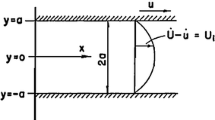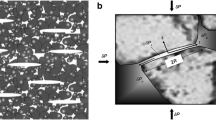Abstract
Rocks in earth’s crust usually contain both pores and cracks. This phenomenon significantly affects the propagation of elastic waves in earth. This study describes a unified elastic wave theory for porous rock media containing cracks. The new theory extends the classic Biot’s poroelastic wave theory to include the effects of cracks. The effect of cracks on rock’s elastic property is introduced using a crack-dependent dry bulk modulus. Another important frequency-dependent effect is the “squirt flow” phenomenon in the cracked porous rock. The analytical results of the new theory demonstrate not only reduction of elastic moduli due to cracks but also significant elastic wave attenuation and dispersion due to squirt flow. The theory shows that the effects of cracks are controlled by two most important parameters of a cracked solid: crack density and aspect ratio. An appealing feature of the new theory is its maintenance of the main characteristics of Biot’s theory, predicting the characteristics of Biot’s slow wave and the effects of permeability on elastic wave propagation. As an application example, the theory correctly simulates the change of elastic wave velocity with gas saturation in a field data set. Compared to Biot theory, the new theory has a broader application scope in the measurement of rock properties of earth’s shallow crust using seismic/acoustic waves.
Similar content being viewed by others
References
Eshelby J D. The determination of the elastic field of an ellipsoidal inclusion, and related problems. Proc Roy Soc of London, 1957, A241, 1226: 376–396
Walsh J B. The effect of cracks on the compressibility of rock. J Geophys Res, 1965, 70, 2: 381–389
O’Connell R J, Budiansky B. Seismic velocities in dry and saturated cracked solids. J Geophys Res, 1974, 79: 4626–4627
Budiansky B, O’Connell R J. Elastic moduli of a cracked solid. Int J Solids Structures, 1976, 12: 81–97
O’Connell R J, Budiansky B. Viscoelastic properties of fluid saturated cracked solids. J Geophys Res, 1977, 82: 5719–5736
Budiansky B, O’Connell R J. Bulk dissipation in heterogeneous media. Solid Earth Geophys Geotech, 1980, 42: l–10
O’Connell R J. A viscoelastic model of anelasticity of fluid saturated porous rocks. Physics and Chemistry of Porous Media. AIP Conference Proceedings, 1984. 166–175
Biot M A. Theory of propagation of elastic waves in a fluid saturated porous solid: A. Low-frequency range. J Acoust Soc Am, 1956, 28: 168–179
Biot M A. Theory of propagation of elastic waves in a fluid saturated porous solid. B: Higher frequency range. J Acoust Soc Am, 1956, 28: 170–191
Biot M A. Generalized theory of acoustic propagation in porous dissipative media. J Acoust Soc Am, 1962, 34: 1254–1264
Tang X M, Cheng C H. Quantitative Borehole Acoustic Methods. Amsterdam: Elsevier Science Publishing Co, 2004
Dvorkin J, Nur A. Dynamic poroelasticity: A unified model with the squirt and the Biot mechanisms. Geophysics, 1993, 58,4: 524–533
White J E. Computed seismic speeds and attenuation in rocks with partial gas saturation. Geophysics, 1975, 40: 224–232
Johnson D L. Theory of frequency dependent acoustics in patchy-saturated porous media. J Acoust Soc Am, 2001, 110: 682–694
Carcione J M, Helle H B, Pham N H. White’s model for wave propagation in partially saturated rocks: Comparison with poroelastic numerical experiments. Geophysics, 2003, 68: 1389–1398
Hudson J A. Wave speeds and attenuation of elastic waves in material containing cracks. Geophys J R Astr Soc, 1981, 64: 133–150
Hudson J A. A higher order approximation to the wave propagation constants for a cracked solid. Geophys J R Astr Soc, 1986, 87: 265–274
Hudson J A. Overall elastic properties of isotropic materials with arbitrary distribution of circular cracks. Geophys J Int, 1990, 102: 465–469
Kuster G T, Toksöz M N. Velocity and attenuation of seismic waves in two-phase media: I. Theoretical formulation. Geophysics, 1974, 39: 587–606
Mavko G, Nur A. Wave attenuation in partially saturated rocks. Geophysics, 1979, 44: 161–178
Pride S R, Berryman J G. Linear dynamics of double-porosity dualpermeability materials: I. Governing equations and acoustic attenuation. Phys Rev E, 2003, 68: 036603
Pride S R, Berryman J G. Linear dynamics of double-porosity dualpermeability materials: II. Fluid transport equations. Phys Rev E, 2003, 68: 036604
Berryman J G, Wang H F. The elastic coefficients of double-porosity models for fluid transport in jointed rock. J Geophys Res, 1995, 100(B12): 24611–24627
Berryman J G. Effective medium theories for multicomponent poroelastic composites. J Eng Mech, 2006, 132: 519–531
Ba J. A study on the seismic wave propagation through multicomponent poroelastic composites. Dotoral Thesis. Beijing: Tsinghua University, 2008
Ba J. Theory of wave propagation through a double-porosity medium and an experimental analysis of its seismic response. Sci Sin Phys Mech Astron, 2010, 40: 1–12
Thomsen L. Biot-consistent elastic moduli of porous rocks: Low-frequency limit. Geophysics, 1985, 50, 12: 2797–2807
Mavko G, Jizba D. Estimating grain-scale fluid effects on velocity dispersion in rocks. Geophysics, 1991, 56, 12: 1940–1949
Johnson D L, Koplik J, Dashen R. Theory of dynamic permeability and tortuosity in fluid saturated porous media. J Fluid Mech, 1987, 176: 379–402
Brie A, Pampuri F, Marsala A F, et al. Shear sonic interpretation in gas-bearing sands. Proceedings of SPE Annual Technical Conference & Exhibition, 1995. SPE 30595: 701–710
Chen Y. Mechanical Properties of Earth’s Crustal Rocks-Basic Theory and Experimental Methods. Beijing: Seismological Press, 140–157
Tang X, Cheng C H. A dynamic model for fluid flow in open borehole fractures. J Geophys Res, 1989, 94(B6): 7567–7576
Cui Z W, Wang K X, Cao Z L, et al. The slow wave of BISQ model in double-porosity media. Acta Phys Sin, 2004, 53,9: 3084–3089
Garland G D. Introduction to Geophysics: Mantle, Core, and Crust. Philadelphia: W. B. Sanders Co, 1987. 117–120
Schubnel A, Benson P M, Thompson B D, et al. Quantifying damage, saturation and anisotropy in cracked rocks by inverting elastic wave velocities. Pure Appl Geophys, 2006, 163: 947–973
Cheng C H, Toksoz M N. Inversion of seismic velocities for the pore aspect ratio spectrum of a rock. J Geophys Res, 1979, 84(B13): 7533–7543
Author information
Authors and Affiliations
Corresponding author
Rights and permissions
About this article
Cite this article
Tang, X. A unified theory for elastic wave propagation through porous media containing cracks—An extension of Biot’s poroelastic wave theory. Sci. China Earth Sci. 54, 1441–1452 (2011). https://doi.org/10.1007/s11430-011-4245-7
Received:
Accepted:
Published:
Issue Date:
DOI: https://doi.org/10.1007/s11430-011-4245-7




